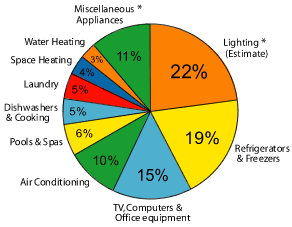This chart shows energy consumption in a typical California home - lighting, appliances, heating & AC use most of the power.

Source: California Energy Commission
Quick Win: Replace bulbs with CFLs can cut home energy usage by 15%.
Add a water heater blanket, and manage indoor temperatures with a programmable thermostat to cut another 7%-12%.
Save 25% by (over time) replacing appliances with Energy Star and we have cut this home’s energy bill in half. Most states and locales provide subsidies and tax credits to help offset purchase costs - click here to find your local subsidies.
When you replace appliances, home entertainment, heating or cooling, use the EPA's EnergyStar best ratings. Energy Star certifies energy efficient items from appliances to air conditioners to TVs, commerical products like fryers & vending machines, and even entire homes. Most Energy Star approved products save 30 - 80% energy vs. other or older models and cost no more. For example, an Energy Star refrigerator can save 50% of the energy vs. a 1993 refrigerator, and can pay for itself in 15 months.
Here's how to prioritize when you upgrade or replace.
1. Refrigerators & freezers use the most energy in your home. Click here to find EnergyStar Refrigerators & freezers that reduce energy consumption 40% vs. a 2001 model Pick a high "% better" model.
2. Home entertainment, PCs & office equipment take 15% of your energy. Energy Star PCs, TVs and audio can cut energy consumption up to 80%. Laptops are more efficient than desktops. Remember PCs and TVs use more power when they are "asleep" than on so turn them off when you're not using them, or plug TVs & office equipment into a smart power strip to save the most energy of all.
3. Water & home heating & cooling take another 15% of power so check here when you replace your heating, air conditioning system or water heater. Upgrading your home insulation , weather stripping and sealing windows can cut energy usage by up to 10% for very little money.
4. Efficient appliances come next. Choose models with the highest Modified Energy Factor (MEF). Run dishwashers and clothes washers only when full. And run hot water through before turning them on to eliminate heating the water again!
5. Solar water heaters and wind and solar power can help in warmer and /or breezy climates and you may qualify for tax incentives.


